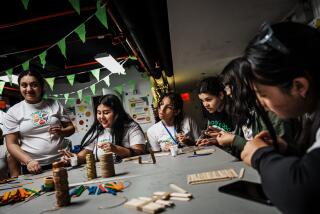At Home in Troop 1900 : Girl Scouts Activities at Shelter Enrich Lives of Children There
- Share via
The 5-year-old girl leans over the balcony railing of the apartment building staircase, her younger siblings toddling down the steps, and beams at the woman standing below in the hallway.
“Hi, Heather!” she calls down.
“How you guys doing?” Heather Hughes asks, glancing up. “Oh, Nakia, remember to wear a T-shirt--something you can get dirty. You’re going to be painting.”
Minutes later, Nakia McLain is downstairs in a pale pink room lined with toys, board games and two sets of encyclopedias. Dressed in an oversized T-shirt, she carries a brown cardboard box to the middle of the floor, spread with a white sheet, and finds a space among other children.
From her box she will create a house, the only house she can call her own at the moment. But that’s what Girl Scout Troop 1900 in the mid-Wilshire district is all about.
As Nakia sets the box down on the floor, it’s nothing more than an unpainted dream with the outlines of three windows on it. But when she’s done, she promises, it will have 15 windows. “Because,” in her mythical family, “there are 15 children,” explains Nakia, herself one of eight.
At first glance, the only sign that Nakia and her friends are part of Troop 1900 is the calendar hanging on a wall: Three well-scrubbed smiling Girl Scouts peer out, attired in uniform green vests and floppy bow ties.
No one in this room is dressed like that. In fact, more than half of them are boys. They don’t own uniforms, it’s unlikely they’ll earn many badges, and they didn’t sell cookies door-to-door this year.
It’s hard to sell cookies when your neighbors are strangers and your home is the fleeting limbo of a homeless shelter.
But that hasn’t stopped the Angeles Girl Scout Council from setting up troops in two homeless shelters, Gramercy Place Shelter in mid-Wilshire and Harbor Interfaith Shelter in San Pedro.
The Girl Scouts have offered the special troops since 1990, free of dues, as much an effort to provide a slice of normalcy to small lives as a traditional Scouting experience.
“For so many of these kids, it’s the first time they’re let off the hook from being little adults,” said Elise Johnson, once a troop leader at the Gramercy Place Shelter and now a social worker there.
Hughes, 24, a student at West Los Angeles College who plans to study social work at Cal State L.A., and Claudia Gonzalez, 23, head the troop Monday through Friday from 2 p.m. to 6 p.m. in a back room of the Gramercy Place Shelter, a nondenominational program run by Jewish Family Service.
The shelter, tucked away in a neat stucco building, has more rules than the Girl Scouts. Residents must be referred from other social service agencies, be clean and sober for six months and take twice-weekly parenting classes. All the residents are families, some with two parents. The families find themselves in the shelter for reasons ranging from drug and alcohol addictions to chronic multi-generational poverty. Children there get almost as much counseling as their parents.
“Every week is different,” says Gonzalez, herself a mother of two and a student at Los Angeles Trade-Technical College. For Martin Luther King Jr.’s birthday, they drew pictures that illustrated bits of his speeches. During cookie-selling season they helped man booths. Now, they’re working with boxes.
“The idea is to make their own little town,” says Gonzalez, “out of their own imagination.” For the final touch, Gonzalez will pull out a box of different colored cardboard figures: “Create your own people,” she explains.
As youngsters aged 5 to 11 trickle in after 2 p.m., they retrieve their boxes in various stages of completion. Hughes puts out cans of paint brushes and containers of paint. Geovanni Martinez, 7, proudly carries his house, painted completely white, atop his head. “I’m going to do another house--in green,” he says.
His 9-year-old brother, Eric, arrives with him. Flushed with energy they dart around the room and verbally spar. The topic turns to what they want to be when they grow up.
“I want to be a President,” says Geovanni.
“You don’t have any money,” shoots back Eric.
“You don’t know. He can be anything he wants to be,” says Hughes as she bustles around the room.
“I want to be a sports guy,” says Eric. “I want to be a football player, a basketball player, do karate. . . .”
“Bo Jackson,” Hughes says. “He’s doing it.”
Hughes helps Mara Peregrina, 7, figure out which way the window shutters on her box house open. Nearby sits her brother, Pedro, 5.
Projects can’t take too long to complete. No one here has much time. The shelter strives to move these often-cyclically homeless families into permanent homes, usually after 90 days. The Peregrinas are expected to leave soon. “They found a house last week,” says Gonzalez.
But that usually means leaving Troop 1900 as well.
“Usually we try to work out a ceremony because they’re leaving,” Gonzalez says. “We’ll do cakes and punch. We’ll sit around and say nice things about her to make her feel special and write her letters before she leaves.”
With the paints arranged and the boxes fetched, the room temporarily falls quiet as brushes swish across cardboard. Occasional murmurs of Spanish and English float through the air.
“Mira! Mira!” says Pedro to his sister, Mara, showing off his house.
Mara’s house has become a virtual trompe l’oeil tableau. On one side, she has painted green bushes and red windows and a white door with a blue border.
Crying out, “I was using this one!” a youngster snatches a brush dipped in brown paint out of Otis Flemings’ hand.
Flemings, 7, hardly blinks as his brush is confiscated. His house is already resplendently painted pink, blue and brown. He switches to another brush and white paint and fashions a white door on a blue background.
The Girl Scouts have gone to great lengths to make sure the boys feel comfortable in the troop. Apparently, it has worked.
“It’s not Girl Scouts,” corrects Kurtis Sims, 11. “It’s just Scouts.”
Otisshia Flemings, 8, explains: “The boys call it Scouts and the girls call it Girl Scouts.”
Otisshia, who has four siblings (Nakia and Otis among them) in the Scout sessions, has lived in the shelter for a month. A quizzical look flutters across her face when she’s asked about it. “This is a shelter?” she asks. “It’s a place .”
By 3:30 p.m., the fifth- and sixth-graders have arrived from school, and Hughes assumes the duties of schoolwork overseer.
“Kurtis, is this graded?” she asks, scrutinizing Kurtis Sims’ math paper and the grade the teacher affixed to it.
“Yeah,” Kurtis, a fifth-grader, says, already at work on his box.
“She wrote A+ in pencil?” asks Hughes.
“She doesn’t got no pens in her school,” answers Kurtis.
Hughes regards him skeptically and checks the math paper again.
“I’m the oldest kid in here,” says sixth-grader Brandon Thompson, 11. Actually there are a couple of 11-year-olds but Brandon has assumed the mantle of older protector. “I like it. I don’t care.”
He scans the room for a paint brush. He has set up his box like a stage set with side walls and painted it orange and red with yellow stripes.
“It’s a McDonald’s,” he explains. “I ain’t that good at houses.”
Otis looks over at Brandon’s elaborate fast food emporium. “I tell you, that boy is an artist,” proclaims Otis.
In fact, Brandon would like to be an artist. “And a football player,” he grins.
He is content to spend his afternoons painting. He has little interest in what he considers traditional Boy Scouting.
“You know how they go hiking? You might get hurt,” says Brandon. “But this is nice. You don’t get hurt.”
“He loves little kids,” says Brandon’s father, Jerry Thompson, later when he comes to pick up his son. Thompson is studying child development at Los Angeles City College. “One more semester and I’m out of there,” he says. The father and son have spent two weeks in the shelter. “We all have our little downfalls in life,” says Thompson. “As long as you get back up, you’re OK.”
As the afternoon rolls on and boxes are finished, the Scouts get restless. Hughes organizes some to help her prepare the tuna salad and others to clean up paint brushes. She coaxes a few to try their homework and eventually sets them all free to run and scream in the fenced-in playground behind the shelter. But Otis and Eric hunker over the bowl of tuna salad in the kitchen off the Scouts’ playroom, two chefs stirring tuna and chopping hard boiled eggs. They are the best of friends.
“When I moved here, he showed me around,” says Otis of Eric. Now they spend their afternoons doing chores together. They spoon tuna salad onto plates and set them out on little tables in the playroom. Everyone comes back in and settles down to eat. But Eric and Otis grab two plates for themselves and return to the kitchen to eat quietly together.
“In this day and age,” muses Hughes about her young charges, “you have to guard these children’s innocence.”







